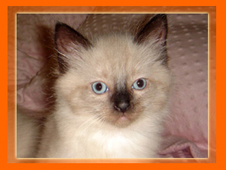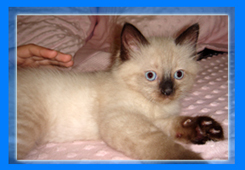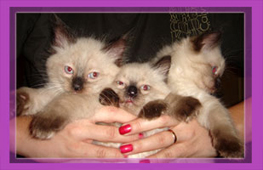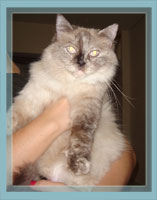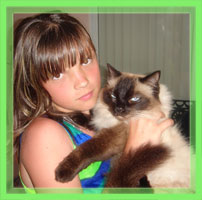 |
 |
 |
|
Click
on Images to view Larger Photos of
the Cats/Kittens
|
|
|
|
~~~~~~~~~~~~~~~~~~~~~~~~~~~~~~~~
Perents
~~~~~~~~~~~~~~~~~~~~~~~~~~~~~~~~
|
|
~~~~~~~~~~~~~~~~~~~~~~~~~~~~~~~~
Breed History
~~~~~~~~~~~~~~~~~~~~~~~~~~~~~~~~
|
| Birman
- The
unusual coloring of the Birman is the subject of a charming legend.
Centuries ago, the Khmer people of Asia built the Temple of Lao-Tsun
in which to worship a golden goddess with sapphire-blue eyes, Tsun-Kyan-Kse.
Mun-Ha, a much-loved priest, often knelt in meditation before the
goddess with Sinh, a beautiful white temple cat, beside him gazing
at the golden figure. One night raiders attacked the temple and Mun-Ha
was killed. As Mun-Ha died, Sinh placed his feet upon his fallen master
and faced the golden goddess. As he did so, the hairs of his white
body turned golden, and his yellow eyes to sapphire-blue, like hers;
his four white legs turned earthy brown - but where his paws rested
gently on his dead master, they remained white as a symbol of purity.
Next morning, the hundred white cats of the temple were as golden
as Sinh, who did not leave the sacred throne until, seven days later,
he died, and carried his master's soul into paradise. Since that time,
whenever a sacred cat died in the Temple of Lao-Tsun, the soul of
a priest was said to accompany it on its journey to the hereafter.
At this point legend ends and history begins. The temple was left in peace until it was raided at the beginning of this century. Two westerners, Auguste Pavie and Major Gordon Russell, came to the aid of the priests; as a gesture of gratitude the priests later sent to the two men, then living in France, a pair of Birman; this was in 1919. Unfortunately, the male did not survive the ocean trip; but the female by then was pregnant, and the survival of the breed in the West was ensured. The earliest pedigrees were lost; the breed as we know it, and which was recognized in France in 1925, stems from one pair, Orloff and Xenia de Kaabaa. But the Birmans were to suffer further setbacks in Europe - after a relatively prosperous period in France in the 1930's, by the end of the Second World War, there was once again only a single surviving pair, and it took many years for the variety to recover. Recognized as a breed in Britain in 1966, the Birman was not recognized in the United States until 1967, when the CFA approved the Standard. They had, however, been shown in "experimental" classes for several years before this, and appeared in championship competition in 1965. Mrs G Griswold owned two, Phass and Klaa Khmer, sent to her from Cambodia, and others were imported from Britain, but the Birman is, nevertheless, a relatively rare cat in America. - from Birman.Org |
| Balinese - What’s so great about a Balinese cat? Everything! Ask anyone who is owned by one of these fabulous felines what is so special about the breed, and you set off a glowing monologue that ends only when the speaker is exhausted. Under that long, silky ermine coat he wears so proudly, this beautiful cat is all Siamese, and that includes his personality. Despite his regal bearing and aristocratic appearance, he is a clown with a heart as big as a circus tent. To gauge the level of his intelligence, you have only to gaze into those sapphire eyes which sparkle with alertness and healthy curiosity. Although he is every bit as demonstrative and affectionate as the Siamese, he is somewhat less vocal and his voice is softer. Grooming is simple, for the coat does not mat like the double coat of most longhaired breeds. - from CFA.Org |
|
|
|
|
|
.........(Breeders,
|
|
|
|
|
|
|

